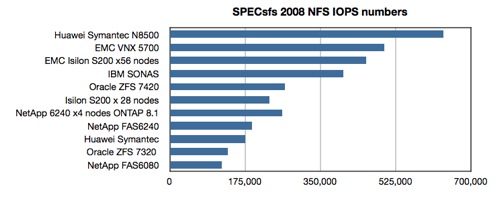This article is more than 1 year old
Oracle pops cork as cut-price ZFS array creams NetApp rival
Plenty more bang for your bucks in SPECsfs2008 benchmark
An Oracle ZFS 7420 storage array provides 40 per cent more performance than a NetApp FAS6240 at a $700,000 lower price point.
That's according to the SPECsfs2008 benchmark, which tests how effective an array is at servicing NFS IO transactions. The chart shows a selection of vendors' SPECsfs2008 IOPS scores in the fewer-than-1-million-IOPS arena. We're not looking at absolute SPECsfs2008 IOPS numbers here but at relative ones.

Selected SPECsfs2008 IOPS numbers
A dual-controller FAS6240 scored 190,675 IOPS, with an overall response time (ORT) of 1.2msecs. It needed 288 hard drives and an exported capacity of 85.8TB to do it.
Oracle's ZFS 7420 scored 267,928 IOPS, with an ORT of 1.31msecs. It was fitted with eight 512GB flash SSDs for read caching, eight more 73GB SSDs for write caching, 280 hard disk drives and a 36.3TB exported capacity. Oracle provide estimated pricing information for the 6240; it's not a requirement that SPECsfs2008 reports include this data, a curious omission.
The 6240's estimated list price is $1,178,868 which means every SPECsfs2008 IOPS cost $6.18. Oracle's own ZFS 7420 costs $430,332 which gives us $1.61 per IOPS.
There is a 4-node NetApp FAS6240 cluster, running Data ONTAP 8.1 in the SPECSfs2008 reports, that scores 260,388 IOPS and an ORT of 1.83msecs. It had 512GB flash cache in each node. That is far closer to the ZFS 7420's performance. Its Oracle-estimated list price is $1,606,048, which gives us $6.17/IOPS, almost four times higher than the ZFS 7420's $/IOPS number.
Interestingly the ZFS 7420 beats a 28-node Isilon S200 cluster, which cost $2,453,708 at a $10.63/IOPS cost. That suggests that the S200 better equip a flash booster as soon as possible. The Isilon clusters go up to 140 nodes and beyond; they are scale-out machines, scoring 1,112,705 IOPS with a 140-node cluster, far, far higher than any ZFS array can achieve.
Back in standard dual-controller array land, the Oracle ZFS array looks like a very cost-effective SPECsfs2008 performer and, by extension, a very cost-effective filer. Oracle is on a bit of a SPECsfs2008 NetApp-bashing expedition at the moment and seems to be enjoying every minute of it. Read Oracle bod Darius Zanganeh's blog to find out more. ®
